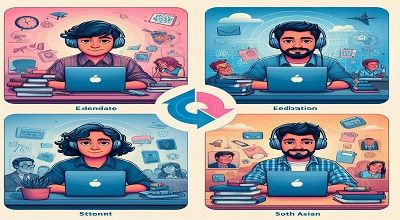4 Stages Of Edtech Integration From A Student Perspective
The integration of educational technology (EdTech) from a student perspective can be understood through different stages. These stages highlight how students experience and adapt to the incorporation of technology in their learning environment. Here are four stages of EdTech integration from a student’s point of view:
Introduction and Exploration:
- Experience: In this initial stage, students are introduced to new technologies in the classroom. This could involve the use of interactive whiteboards, educational apps, or online platforms.
- Feelings: Students may feel excited, curious, or even a bit apprehensive about the new tools. The novelty of technology in the learning process can create a sense of wonder.
- Challenges: Some students may face challenges in navigating and understanding the new technology. There might be a learning curve associated with adapting to digital tools.
Familiarization and Skill Development:
- Experience: As students continue to use EdTech tools, they become more familiar with the platforms and develop basic skills. They start using technology for assignments, research, and collaborative projects.
- Feelings: Confidence grows as students become more proficient in using technology for educational purposes. However, frustration may still arise if they encounter technical difficulties or if the tools are not intuitive.
- Challenges: Students may face challenges related to digital literacy and troubleshooting issues. Teachers play a crucial role in supporting students during this stage by providing guidance and resources.
Integration and Customization:
- Experience: At this stage, students seamlessly integrate technology into their daily learning routine. They leverage digital tools to enhance their understanding, collaborate with peers, and access a variety of learning resources.
- Feelings: Students feel empowered and independent as they customize their learning experience using technology. They appreciate the flexibility and convenience that EdTech brings to their education.
- Challenges: While students may be adept at using technology, they might encounter challenges related to distractions or the need for digital well-being. Educators focus on guiding students in responsible and effective technology use.
Mastery and Autonomy:
- Experience: In the final stage, students have mastered the use of EdTech tools and can apply them across various subjects and projects. They may even explore advanced features or seek out new technologies independently.
- Feelings: Students feel a sense of autonomy and ownership over their learning journey. They recognize the value of technology in acquiring knowledge, problem-solving, and preparing for future endeavors.
- Challenges: Students at this stage may face challenges related to staying updated with evolving technologies. Continuous support from educators and access to professional development opportunities help them navigate these challenges.
Final Summary
In summary, It’s important to note that students may progress through these stages at different rates, and the effectiveness of EdTech integration depends on various factors, including the quality of technology, teacher support, and the overall educational environment.
